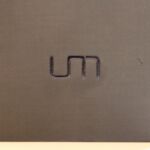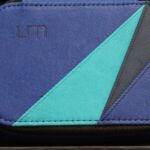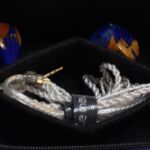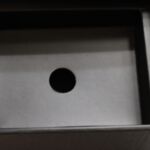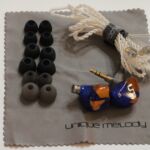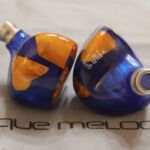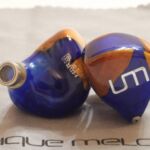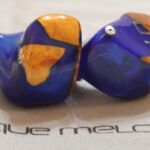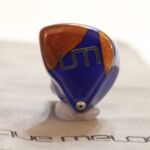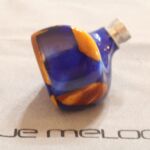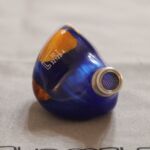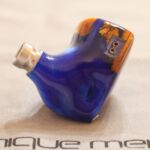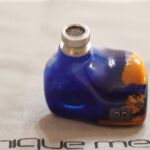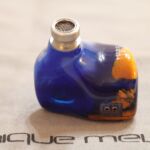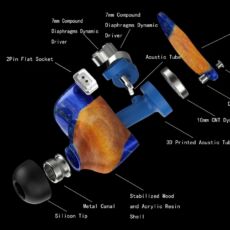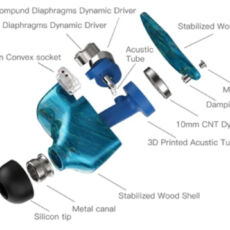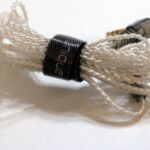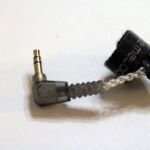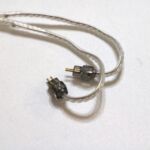Unique Melody 3D Terminator (3DT)
disclaimer: I borrowed the Unique Melody 3D Terminator from Ngoshawk Sounds for purposes of this review. Ngoshawk runs a great site too so if you haven’t visited it yet, please do. I have had no contact with Unique Melody regarding this review, nor have I received any remuneration for same. If you have an interest in Unique Melody products, please see their website and follow them on Facebook. Unfortunately, the 3DT does not seem to be listed on UM’s website at the time of this writing. If you want to purchase your own 3DT, see MusicTeck where it is currently on sale at $319 USD.
Unboxing / Packaging:
Understand that since this was a borrowed iem, the unboxing experience may be slightly different than retail. The 3DT came in a book-fold style box in matte black with the UM logo impressed in gloss black on the lid. Lifting the lid reveals the soft case with all the goodies hiding inside. The case is good sized and matche the color choices of the 3DT with shades of electric blue accented with darker nave and lighter teal swatches. The case is good sized and allows for taking the earpieces, cable and accessories with when on the go and even provides a divider that can be used to keep the earpieces from scratching in transit (Good idea that). The kit is fairly standard with case, divider, earpieces, cable, cleaning cloth, velcro cable tie, and 6 sets of silicone tips in two styles.
Build/Fit:
Construction is a mix of resin and stabilized wood so each pair is unique with some having mostly stabilized wood and others having more of a balance between wood and resin like this pair does. I have to admit I really like the wood and wish these had a higher percentage of the shell made of the wood but beggars cant be choosy right? Shells are a 3 piece design with a composite (resin/wood) face plate and inner shell and an aluminum nozzle. Size of the shell is medium with a bit above average thickness due to the driver arrangement. Fit and polish is what one would expect from a company that usually makes $1k+ in-ears with a fingernail unable to find the seam between face and inner shell. Face plates have the UM logo in silver and a single metal (steel?) vent immediately behind the nozzles. Nozzles have a slight forward rake when sitting in ear and insertion depth is good due to a rise the nozzle rests on and the angle of the nozzle. (I mention this as the nozzle looks a bit stubby but was not a problem in use). I found the 3DT comfortable for long wear but those with small ears may want to audition the 3DT first. Also I’m not a huge fan of memory wire so were these mine, I’d probably surgically remove it or change cables.
Internals:
Well typically when we talk about a triple driver model it is either some form of hybrid or and all balanced armature affair so finding a 3 driver model where all three are dynamic drivers is a bit of a unique melody (sorry couldn’t resist). The 3DT ues a pair of a 7mm compound diaphragm dynamic drivers to handle the bass/subwoofer duties and a carbon nano-tube diaphragm 10mm dynamic to handle everything from the lower-mids up. Nominal impedance is listed as 25.4Ω with a sensitivity of 113 dB/mW at 1kHz. I found the 3DT fairly easy to drive and it worked well from my aging LG and newer Samsung phones (with a sparrow dongle). I did find the 3DT scales well with source and didn’t have any appreciable hiss until moving to something ridiculous like the Ta-30. It paired very nicely to the WM1A where the warmth of the 3DT complemented the cooler presentation of the Sony.
Cable:
This is the weak point of the 3DT package as the cable is pretty cheap looking compared to the earpieces. That is not to say it is poorly made as it seems to work well, just that the narrow gauge silver-plated copper strands don’t look like anything you might not find in the $50 class of offerings. The south end starts with a 90º 3.5mm jack with a gray translucent casing and a good strain relief. The cable itself is silver-plated copper in a clear housing in a 4 wire double twist pattern up to the splitter. This is the weakest point as the splitter is a clear plastic tube and doubles as the chin slider so there is no strengthening at the junction between four and two wire braids if used as a chin slider. This may last well, but only time will tell and it certainly is an unconventional cost saving measure for a $400 retail in-ear. North end terminations are earhooks with memory wire and .78mm bi-pin connectors in gray translucent housings that match the jack. A velcro tie is also provided for storage.
Sound:
Bass:
From a triple dynamic driver with two of them dedicated to bass, we expect big bass performance and the 3DT delivers. Sub-bass is emphasized centered around 50Hz or so with roll-off only notable in the lower 20Hz range. These have a lot of rumble and while not a dedicated basshead in-ear, they should please the crowd looking for low-end thump. Mid-bass shares the emphasis and slowly drops back as it moves up toward the lower mids. The speed of the drivers is fast enough to keep the lows from getting too murky but decay lingers enough to give these an overall warm tone and some minor bleed into the lower mids is perceptible. Textures are about average but dynamics are quite good which is a trade off we often see with well dynamic drivers.
Mids:
Lower mids do have some bleed that makes them a bit warm and slightly thick at times but stops short of being obstructive as male vocals have good weight and texture and cut through the instrumentation well. Guitar growl is acceptable but not quite as sharp edged as realistic (probably due to extended decay). True mids represent the bottom of the V but are not markedly recessed although strings do lack a bit of energy needed to have a completely natural tonality. I suspect these were tuned more for popular genres as the tuning excels at hip-hop, pop, EDM and rock, but is less perfect for quartet, concerto and orchestral works. Upper-mids do push forward again and female vocals are a step forward as a result but have good timbre and note weight and here again don’t sound out of place. I found no hint of stridency here and if anything, the 3DT seems slightly relaxed in its upper-mids.
Treble:
Lower treble plateaus out after the upper mid climb and stays comfortable if emphasized a bit. Above the lower treble emphasis the treble falls back rather quickly and unlike the mids where the graph seems to overstate the recess, here to my ear, the 5-7kHz range is more recessed and noteworthy than the graph may suggest. Snare rattle has good crispness but hi-hat and crash cymbals lack the energy needed to be realistic. I understand the tuning decision, cut out the area that fatigues most users and add back a bit around 8kHz to keep the sound open but to my ear, it goes a bit too far toward polite and could use a bit more energy in the true treble and a higher roll-off to keep things airy and realistic. The roll-off is between 11-12kHz and is fairly sharp above that point which limits the 3DT.
Soundstage / Imaging:
The 3DT has a bit more width than depth and some height but stops short of being holographic mostly due to the height limitation. I classify the 3DT as a small theater presentation in the overall, not overly intimate where it pushes everything immediately in front, but certainly not cavernous either. Seating the orchestra is straight forward with above average instrument separation which seems odd to be saying about a triple dynamic. Perhaps oddly, the layering in the lows is quite good but there seems to be a little congestion in the upper-mids that takes a bit away from the violins as a result. Imaging is good with movements easily tracked and fairly precisely placed in space but overall probably about average for the class.
Comparisons:
The 3DT exists in a crowded space at $350-$400 retail depending on reseller. This puts it in direct competition with things like the Moondrop Blessing 2, LZ A7, FLC 8N, and BGVP DM6. The fact that I have rated all of the above as recommendations in times past should be a hint that this is a tough bracket and there isn’t likely to be a single declared winner. Indeed choosing between these will likely come down to preferred signature and small details as all are quite good.
Moondrop Blessing 2 – the 3DT is prettier for sure, but both share similar resin construction with the Blessing2 being slightly larger. Sound wise, the Blessing2 is more linear with less low-end slam and rumble compared to the 3DT, but a bit more forward and better detailed mids in the trade off. The treble is less organic and not quite as natural sounding on the Blessing2 but here again, detail is better and extension favors the Blessing2. Basically this fight comes down to what you want an in-ear to sound like. For near reference, go Blessing2, for more fun and engaging the 3DT wins out.
Lz A7 – the shell on the LZ is aluminum and smaller but uglier than the 3DT for sure. The A7 has a more industrial feel while the 3DT has a more art look. The A7 again adds tuning options to tweak with both a cross-over adjustment (switch) and filter sets and the option to use some 3rd party filters as well. The A7’s base signature has good slam and rumble but falls a bit short of the low-end of the 3DT. Mids favor the A7 with a bit more mid presence and more micro-detail while the timbre is a bit more organic and engaging on the 3DT. Again, preferences are going to decide which you choose.
FLC 8N – Shells have nothing in common with the 8N using a machined aluminum shell and having a ton of tuning options. Those options can be both a blessing and a curse as often I find the filters easily lost and sometimes the perfect combo doesn’t exist. The upside of those filters is that the signature can be varied quite a lot so it can be near reference or can be tuned for more of a V signature. When tuned as closely as possible to match the 3DT, the 8N has less rumble and slam than the 3DT but can mimic the remaining frequency response fairly closely with similar detail level . Timbre is a bit better on the 3DT treble while extension slightly favors the 8N.
BGVP DM6 – Both resin shells again, but again the 3DT is the better looking of the two shells in my estimation. The lows are more emphasized on the 3DT with better slam and rumble compared to the DM6 which is a bit more reference tuned but lacks some authority in the lows. Mids are a bit more forward on DM6 with improved micro-detail compared to the 3DT, but again the treble on the DM6 while better extended is also prone to sibilance and can become strident and fatiguing while the 3DT is a bit more laid back.
Thoughts / Conclusion:
Unique Melody has built quite a following for their iems over the years but isn’t a household name due to the average price tag of their models being in the thousands of dollars. The 3DT represents an unusual foray into affordable territory for UM and gives many who might not have otherwise had an opportunity the chance to try out the brand. The 3DT has a really engaging signature and one that succeeds in a lot of regards despite an FR chart that might suggest otherwise. The bass is elevated but the dynamics are there to support it and keep it from becoming a one trick pony and the mids while seemingly recessed considerably on the FR are actually on a nearly even footing with the rest of the signature when listened to. The place the UM falls down is in its treble presentation where it opts for safety and will make the treble sensitive happy but does not have the extension to really portray percussion accurately. That lack of treble energy and a slight tendency for the upper-mids to get a bit congested keep the 3DT from being a world beater at the price point. Still it holds its own against fierce competition and those looking for a warmer more dynamic tonality than things like the Blessing 2 and LZ A7 offer will find the 3DT a welcome change of pace.
-
Bass - 8/108/10
-
Mids - 7/107/10
-
Treble - 7/107/10
-
Soundstage - 7.5/107.5/10
-
Imaging - 8/108/10
Summary
Pros: great build, very engaging signature, more affordable than most of UM line, nice case
Cons: cable not up to standard of earpieces, not reference tuning, bass may be too exaggerated for some.


